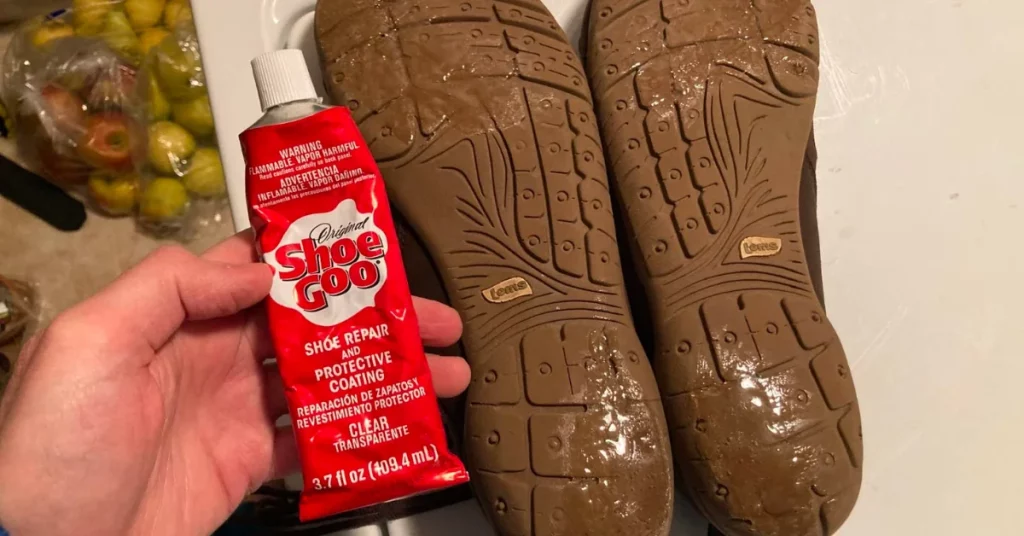Shoe Goo is one of the household names you will run into while searching for the glue to repair or fix your shoes and other household items. Shoe Goo is a versatile, widely available, and relatively easy-to-use adhesive.
However, you may wonder does Shoe Goo work on the materials your boots are made of. In this article, I’ll go over materials Shoe Goo works best on, materials you should avoid using Shoe Goo on, and more.
Read More: Shoe Goo vs. Loctite Shoe Glue
What is Shoe Goo?
Shoe Goo is an adhesive made for repairing and fixing shoes but works well with various materials, making it suitable for household repairs and DIY Projects. Shoe Goo is a particular type of rubber cement that functions as an adhesive and a sealant, so you can use it to fill up small gaps or holes in your shoes.
Shoe Goo works well with materials like – Leather, Vinyl, Canvas, and Rubber, so it’s versatile and suitable for multiple components of your shoes and other household repairs.
Shoe Goo also works for Plastic, Wood, Concrete, and Metal; however, Shoe Goo has a comparatively longer drying time than other alternatives. Shoe Goo is based on a formula composed of Styrene-butadiene, Toluene, and Solvent naphtha, making it an ideal sealant besides an adhesive.
Since Shoe Goo can work as a sealant, you can seal small holes and gaps in your boot heels or any material made of Rubber, Plastic, Vinyl, Canvas, Metal, or more. Shoe Goo is entirely waterproof once the glue is appropriately set and bonded, so you can use it for Shoes you use in wet conditions.
Shoe Goo creates a flexible bond once it’s cured, so you can use it to repair boots you use recreationally or for casual sports purposes. Shoe Goo comes in clear color and tubes of 0.18 fl oz, one fl oz, and three fl oz.

Read More: Aquaseal vs. Shoe Goo
Does Shoe Goo Work On Plastic, Leather, Fabric, Metal, Rubber, Wood, Crocks?
Materials Shoe Goo Work Best On
Shoe Goo is an excellent adhesive that forms a strong, robust bond once fully cured, making it ideal for various shoes and household repairs. Shoe Goo works on different materials, and even though it is made to repair and fix shoes, you can use it with materials unassociated with shoes.
You can use Shoe Goo on plastic, and you can use it to repair shoes and shoe parts made of vinyl plastic. Furthermore, you can also use Shoe Goo for other household fixes, like a layer of Shoe Goo on the lower end of the keyboard to protect it from scratching.
Shoe Goo is ideal for Leather, and you can use Shoe Goo to repair and fix your leather shoes or boots. However, once you use the glue, you’ll need to leave it undisturbed for a day or more for it to be completely cured.
While Shoe Goo works on Fabric, other alternatives will repair and fix them faster. However, you can also use Shoe Goo to improve sports bags or patch holes and tears.
Shoe Goo also works on Metal, but similar to fabric; there are better and quicker alternatives. That being said, you can also use Shoe Goo to repair cracks in computer cases or reattach handles to cabinets, cabinet drawers, sewing boxes, food boxes, etc.
Shoe Goo works excellent on Rubber, and you can use the glue to repair and fix rubber boots and soles. Shoe Goo is entirely waterproof once fully cured, so you can use Shoe Goo to improve rubber boots you use in wet conditions or during rain.
Shoe Goo also works on Wood, but if you don’t want to wait the long drying time of Shoe Goo, you can go for the better, quicker alternatives.
However, you can use Shoe Goo as a sealant for cracks and tears on various household wooden objects you have. You can use Shoe Goo to seal cracks in your wooden logs, cups, plates, and more.
You can use Shoe Goo to repair and fix your crocs; since it creates a solid but flexible bond once it’s cured, it can be an ideal choice to improve your crocs.
Furthermore, you can also use Shoe Goo to repair and seal up cracks in concrete walls, but better alternatives exist.
Read More: Shoe Goo vs. Shoe Goo 2
Last Opinion
In the article, I went over the question of does Shoe Goo works on materials shoes are commonly made of and more.
Shoe Goo works excellently for various materials like Leather, Vinyl, Plastic, and Rubber, so you can repair multiple of your boots and their components without worrying.
Furthermore, Shoe Goo is waterproof, works as a sealant, and forms a flexible bond once cured, making it ideal for many more household repairs and fixes.
Shoe Goo forms a strong bond, but a complete cure takes between 24 hours to 48 hours, so you can use it to repair boots and more as long as you can wait out the cure time.
Shoe Goo is an ideal adhesive and sealant, which is also versatile since you can use it to repair boots, their components, and various other household items.

